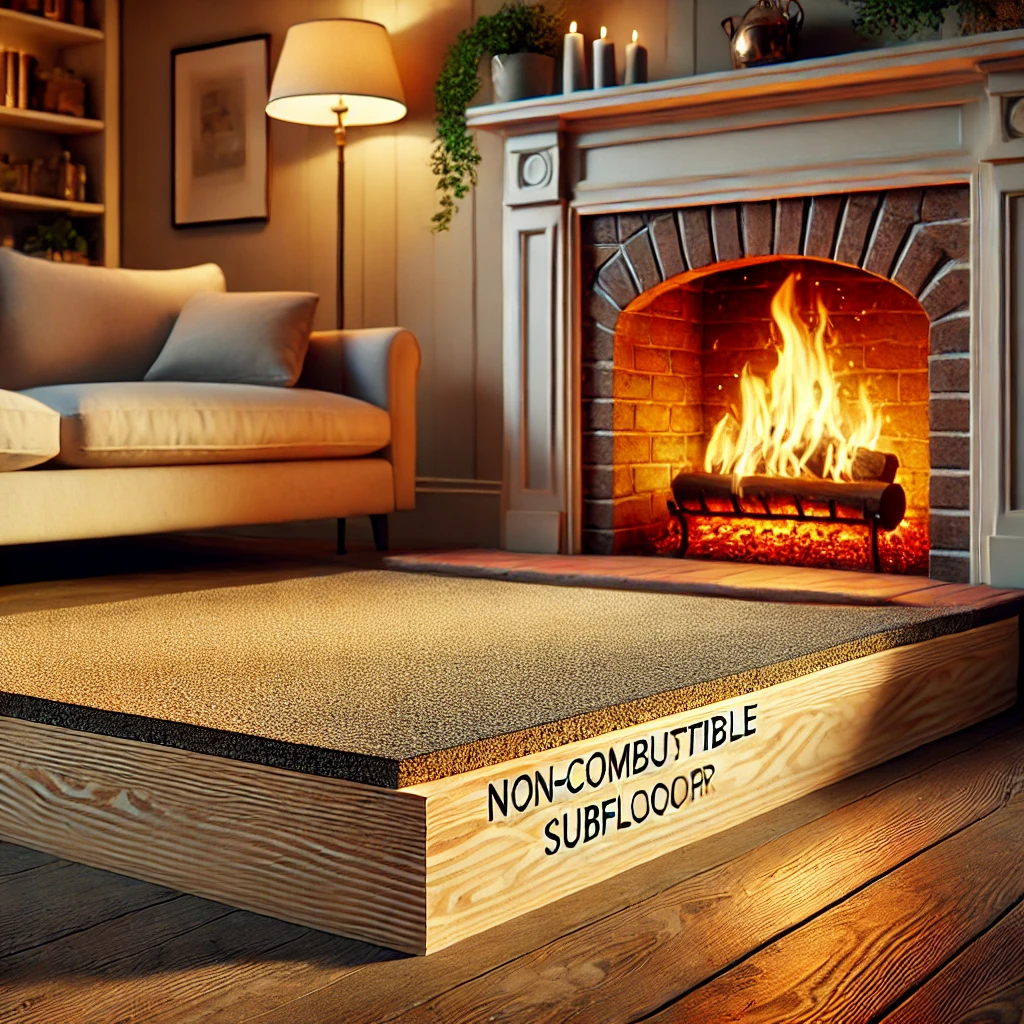A fireplace can be a wonderful addition to any home, offering warmth, ambiance, and a cozy atmosphere. However, safety should always be the top priority when constructing or maintaining a fireplace. One common question that arises is whether plywood under a fireplace hearth is a fire hazard. In this comprehensive guide, we’ll dive deep into this topic, and explore the risks, building codes, alternatives, and practical solutions to ensure your fireplace setup is both safe and stylish.
Fireplaces have been used for centuries to heat homes, and they continue to be a popular choice for many homeowners. However, safety concerns, particularly regarding the materials used in the construction of the fireplace hearth, are critical. One of the most pressing questions is whether plywood under a fireplace hearth is a fire hazard.
Plywood is a commonly used construction material, but it is also flammable. When used in proximity to high heat sources like a fireplace, it may pose significant safety risks. In this post, we will explore the potential hazards of plywood under a hearth, discuss what building codes say, and offer safer alternatives to ensure your home remains protected from fire risks.
What is Plywood?
Plywood is an engineered wood product made from thin layers, or “plies,” of wood veneer that are glued together. Each layer is rotated 90 degrees relative to adjacent layers, which provides plywood with its strength and resistance to warping. Plywood is widely used in construction because of its versatility, affordability, and ease of use.
However, plywood’s composition means it is highly combustible. While some types of plywood can be treated with fire-retardant chemicals, standard plywood can catch fire quickly and should be kept away from direct heat sources.
Why Plywood May Be Used Under a Fireplace Hearth

Plywood may be used in the subflooring underneath a fireplace hearth for a variety of reasons. Often, builders use plywood as a base material to support the final hearth surface, which may be made of non-combustible materials like tile, stone, or brick. Plywood is often selected for its structural integrity and ease of installation.
Despite its practical uses, plywood’s flammability makes it a questionable choice under a fireplace hearth, which will be exposed to high temperatures. The hearth is meant to protect the floor and surrounding area from heat, sparks, and embers, so the materials used beneath the hearth must be carefully chosen.
Is Plywood Under Fireplace Hearth a Fire Hazard?
Yes, plywood under a fireplace hearth can be a fire hazard. Since plywood is a combustible material, prolonged exposure to heat, sparks, and embers from the fireplace can cause it to ignite. Even if the plywood is not directly exposed to flames, the heat transfer from the fireplace could cause it to smolder and eventually catch fire.
Key Risks of Using Plywood Under a Fireplace Hearth:
- Combustion Risk: Plywood is a highly combustible material. If exposed to enough heat or stray embers, it can easily ignite, posing a fire risk to the entire home.
- Heat Transfer: Fireplaces generate a lot of heat, and even with a hearth in place, that heat can transfer down to the subfloor. If plywood is used as a subflooring material, it can heat up over time, increasing the risk of combustion.
- Improper Insulation: If the plywood is not adequately insulated from the heat of the fireplace, the temperature could reach unsafe levels, which might lead to smoldering or fire.
- Long-Term Deterioration: Plywood that is repeatedly exposed to heat can deteriorate over time, weakening the structure and increasing the risk of fire.
Building Codes and Fireplace Safety Regulations
Building codes are put in place to ensure that fireplaces are constructed safely and efficiently. In most regions, the use of plywood in proximity to a fireplace is strictly regulated, and it is usually required that non-combustible materials are used for the hearth and subfloor.
Key Fire Safety Regulations:

- Non-Combustible Hearth Materials: According to the International Residential Code (IRC), the fireplace hearth and surrounding materials must be made of non-combustible materials. This means that wood, including plywood, is typically not allowed under or near the fireplace.
- Clearance Requirements: Fireplaces must have a specified clearance from combustible materials. The required clearance can vary depending on the type of fireplace (e.g., wood-burning, gas, or electric).
- Fire-Rated Insulation: If combustible materials like plywood are present near a fireplace, they must be adequately insulated with fire-resistant barriers.
It’s important to check your local building codes or consult a professional to ensure that your fireplace construction meets all safety regulations.
Safe Alternatives to Plywood Under a Fireplace Hearth
To avoid the risks associated with plywood, it’s important to use non-combustible materials under your fireplace hearth. Here are some alternatives that can provide the necessary structural support while ensuring fire safety:
1. Cement Board
Cement board is a popular choice for subflooring under hearths because it is non-combustible and offers excellent heat resistance. It is also durable and provides a solid base for hearth materials like tile or stone.
2. Concrete Slab
A concrete slab is a permanent, non-combustible option that provides excellent fire resistance and structural support. Concrete is commonly used in high-heat environments because it can withstand extreme temperatures without igniting.
3. Metal Sheets
Steel or aluminum sheets can be used as a heat barrier under the hearth. While metal is conductive, it can be paired with other fireproof materials to provide both structural support and heat resistance.
4. Stone or Tile
Natural stone or ceramic tiles are excellent materials for hearth surfaces. Both are non-combustible and can be installed over a cement board or concrete base to provide a fire-safe hearth.
How to Safely Install a Fireplace Hearth
If you’re constructing or renovating a fireplace, it’s essential to follow safety guidelines to ensure that the hearth and surrounding areas are fireproof. Here’s how you can safely install a fireplace hearth:
Step 1: Choose the Right Subfloor Material
Start by selecting a non-combustible material like cement board or concrete for the subfloor. Ensure that the material you choose meets local building codes and provides sufficient insulation from the heat of the fireplace.
Step 2: Install a Heat-Resistant Barrier
If your subfloor contains any combustible materials, it’s essential to install a heat-resistant barrier between the fireplace and the subfloor. This barrier can be made of metal, stone, or fire-resistant insulation.
Step 3: Use Non-Combustible Hearth Materials
The surface of your hearth should be made of non-combustible materials such as stone, tile, or brick. These materials will protect the floor from the heat, sparks, and embers generated by the fireplace.
Step 4: Maintain Proper Clearance
Ensure that the fireplace has adequate clearance from any combustible materials, including walls, furniture, and decorations. This clearance will help prevent accidental fires.
Preventing Fire Hazards Around the Fireplace

In addition to using the right materials for your hearth, there are several steps you can take to prevent fire hazards around the fireplace:
- Install a Fire Screen: A fire screen can prevent embers from escaping the fireplace and landing on combustible materials.
- Keep Flammable Items Away: Ensure that furniture, curtains, and other flammable items are kept at a safe distance from the fireplace.
- Use the Right Fuel: Only burn seasoned firewood in wood-burning fireplaces. Avoid burning paper, trash, or treated wood, as these can produce dangerous sparks and fumes.
- Clean the Chimney Regularly: Creosote buildup in the chimney can lead to chimney fires. Have your chimney cleaned regularly to prevent this risk.
Signs of Fire Hazards: When to Take Action
If you notice any of the following signs, it’s time to take immediate action to prevent a fire:
- Scorch Marks on the Hearth: If the hearth or surrounding materials show signs of scorching or discoloration, this could indicate that the area is exposed to excessive heat.
- Smoldering or Smoke Smell: If you smell smoke or notice smoldering around the hearth, this could indicate that combustible materials are heating up.
- Cracks in Hearth Materials: Cracks in the hearth surface can allow heat to penetrate deeper into the subfloor, increasing the risk of fire.
Professional Inspection and Maintenance
To ensure that your fireplace and hearth are safe, it’s important to schedule regular inspections and maintenance. A professional can check for signs of wear, ensure that the materials used meet safety standards, and make any necessary repairs.
Benefits of Professional Inspection:
- Detect Hidden Risks: A professional can identify fire hazards that may not be visible to the untrained eye.
- Ensure Compliance: A certified inspector will ensure that your fireplace meets all local building codes and safety regulations.
- Prevent Future Fires: Regular maintenance can prevent fires by addressing issues before they become serious problems.
Conclusion
In conclusion, using plywood under a fireplace hearth is indeed a fire hazard due to its combustibility and inability to withstand high heat. To prevent the risk of fire, it’s essential to use non-combustible materials like cement board, concrete, or metal under your fireplace hearth. Following local building codes and ensuring proper clearance from combustible materials is crucial for maintaining a safe and functional fireplace.
Always consult a professional when constructing or renovating a fireplace to ensure all safety standards are met. By taking the necessary precautions, you can enjoy the warmth and comfort of your fireplace without compromising the safety of your home.


